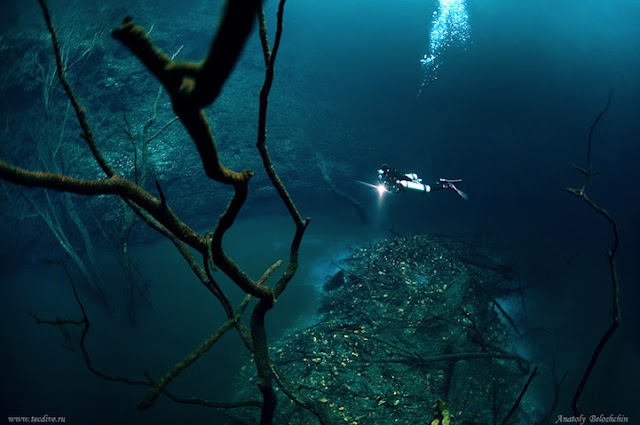
"The farther the forest looks greener, the more beautiful and dangerous it is from the inside"
love them or hate them but you can't deny there is an unidentifiable mystery with the caves. many of the dive sites are in the world some are found within these underground holes. Cave diving is an underwater sport, it is also practised by scientists and research teams interested in making new aquatic discoveries. For scuba divers, cave diving is seen as on the riskiest, yet most rewarding, experiences that a diver can have.
These 6 awesome cave dive sites are sure to test your limits.
- INDIAN SPRINGS - FLORIDA, USA
- CENOTE ANGELITA - TULUM, MEXICO
- BEN’S CAVE - LUCAYAN NATIONAL PARK, GRAND BAHAMA
- KILSBY’S SINKHOLE - MT GAMBIER, SOUTH AUSTRALIA
- EMERGENCE DU RUSSEL - DORDOGNE REGION, FRANCE
- EL CENOTE - PLAYA GIRON, CUBA
1. INDIAN SPRINGS - FLORIDA, USA

Indian Spring Located on private property just south of Tallahassee, Florida. Indian Springs is often the best cave dive in North America. The main route tunnel reaches 600 feet (183 meters) before coming to a T-junction. At this point, divers can turn right to head upstream or left to go downstream. There are several points of interest within the cave including the Bone Narcosis Room, the Wakulla Room and the Power Room. Keep in mind that the average depth for a dive in Indian Springs is between 120 and 180 feet (37 and 55 meters), making this a technical dive as well as a cave dive.
Required Certification: Full Cave Diver, Trimix and Proof of 100 Cave Dives
When to Go: Mid April to October
2. CENOTE ANGELITA - TULUM, MEXICO

Cenote Angelita, found in the Riviera Maya in Mexico, is truly a place like no other. Cenote Angelita is famous for its hydrogen sulphide. This layer looks like an underground river at 100ft. To get to it, you have to travel through a lush jungle environment. And once you see this place in person, you will be truly captivated by the awe-inspiring beauty of it and its deep blue water. The name of this place translates to “little angel,” and it is located about 10 to 15 minutes south of Tulum. The hydrogen sulphide cloud looks like a riverbed beneath you, complete with large branches of trees, and even leaves, coming up out of it. divers enjoy because of the hydrogen sulphide layer which you will find at 30 meters / 100 ft. This layer creates a sort of mystical cloud between the salt and fresh water. It is as though you have entered a world of fantasy, and you have to experience it to understand just how breathtaking it is. The cenote descends to 60 metres or 180ft, a depth which should only be dived if you are trained to do so.
Required Certification: Advanced Open Water
When to Go: May to September
3. BEN’S CAVE - LUCAYAN NATIONAL PARK, GRAND BAHAMA

Grand Bahama is home to the longest freshwater cave system in the world. Measuring in at 6 miles (9.5 kilometres), the system is home to mosquitofish, shrimp, freshwater eels and an endemic species of crustacean. Although several caves exist, only Ben’s Cave is open to scuba diving. In addition to the fascinating mix of fresh and saltwater, you’ll also see stalactites, stalagmites and fossilized conch shells in the cave. Similar to the cenotes in Mexico, Ben’s Cave is ideal for novice divers wanting to try out the world of cave diving.
Required Certification: Open Water
When to Go: October to June
4. KILSBY’S SINKHOLE - MT GAMBIER, SOUTH AUSTRALIA

The clarity is the thing in the ocean, you might get 10-20 metres. You’re excited with ten metres. But the sinkhole is like diving in crystal clear water. You can see 50 metres or more.”
Sinkhole diving and cave diving especially can be very dangerous, and parts of the Kilsby Sinkhole are restricted to those with specialised certification, air mixes and equipment. “It’s understandable how people get into danger — it’s alien to what you’re used to, even as a diver, and you can forget about some of the more important safety things, such as losing track of your buoyancy because it’s so breathtaking
Required Certification: Open Water (for non-overhead areas) or Cave Diver (for overhead areas)
When to Go: Year-Round
5. EMERGENCE DU RUSSEL - DORDOGNE REGION, FRANCE

France’s Lot and Dordogne regions are known to have the best cave diving in Europe, but one cave alone makes the trip worthwhile. That is the Emergence du Russel. Russel boasts a 2.5-mile (4-kilometre) loop that begins at a fork just beyond its entrance. One of the passages is 30 feet (9 meters) deep and the other descends to 60 feet (18 meters). While most divers will never complete the loop, the challenge attracts cave diving experts from around the world.
Required Certification: Cavern Diver
When to Go: April to October
6. EL CENOTE - PLAYA GIRON, CUBA

Located in the Zapata Marshes near Playa Giron, El Cenote is a limestone formation connected the sea with a big lake. El Cenote has not yet been thoroughly explored, but it is known that its side fissures travel down to at least 230 feet (70 meters). The entrance itself is at 66 feet (20 meters), but the dive is limited to 100 feet (30 meters) with a passage through a 2600-foot (800-meter) tunnel. There are lots of coral reef fish living in the cave as well as interesting rock formations to view. Overall, El Cenote offers a great alternative to open water diving in Cuba.
Required Certification: Advanced Open Water
When to Go: November to April
Happy and safe cave diving!!!







0 Comments